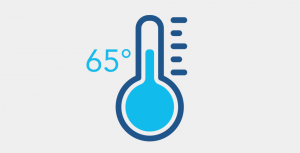What Temperature is Parylene Applied At?
Posted by Sean Horn
Friday, August 3, 2018 7:30
@ 7:30 AM
Parylene (XY) conformal coatings are applied to substrate materials through a specialized chemical vapor deposition (CVD) process that completely eliminates the liquid phase of wet coatings. No initiators or catalysts are involved in CVD polymerization, which synthesizes truly conformal protective film in-process. This is in stark contrast to wet coating materials such as acrylic, epoxy, silicone and urethane, which are synthesized prior to application via, brush, dip or spray methods. Wet during application, liquid-coated substrates requiring further drying and curing.
 With parylene CVD deposition, a gaseous monomer uniformly encapsulates all exposed substrate surfaces; no curing is necessary. Temperature levels influence outcomes of CVD throughout the process, from sublimation through pyrolysis and cold trap procedures.
With parylene CVD deposition, a gaseous monomer uniformly encapsulates all exposed substrate surfaces; no curing is necessary. Temperature levels influence outcomes of CVD throughout the process, from sublimation through pyrolysis and cold trap procedures.
Sublimation – Dimer Transformation
In contrast to liquid coating materials, parylene initiates CVD as a solid, stable powdered crystalline dimer di-p-xylylene. CVD’s first phase — sublimation – begins with positioning dimer in an aluminum foil cup – the “boat” — situated at opposite end of the deposition chamber, where actual coating will ultimately take place, Final coating thickness is determined by the volume of dimer placed in the boat.
CVD processing begins with radiant heater cycling within the unit.
Regarding process temperature, dimer is heated to levels between 120° – 150° Centigrade (C) under vacuum conditions, transforming the substance into a vapor. A pressure safety interlock cycles the radiant heater/vaporizer on-and-off according to coating project requirements, to regulate safe operating performance. As dimer changes from solid-to-vapor, its molecules move down the tube because of the reduced pressure at the opposite end.
Parylene Pyrolysis
Pyrolysis is essentially decomposition of a substance, in this case solid parylene dimer, brought about by exposure to high temperatures. Consisting of two parylene molecules, the dimer undergoes this transition at temperatures ranging between 650° – 700° C. This level of heat causes the molecules to split apart forming the reactive, vaporous monomer p-xylylene. This resulting monomeric vapor becomes the parylene conformal coating when it reaches the item to-be-coated in the deposition stage.
Cleaved into divalent radical monomers by these high temperatures, monomer molecules:
- enter the deposition chamber,
- making approximately 10,000 collisions with other similar vaporous molecules,
- eventually reconstructed as a single, long chain polymer on ALL exposed substrate surfaces within the chamber,
- regardless of topography;
- crevices and edges are covered,
- providing a uniform, pinhole-free coating
- that penetrates within substrate surfaces while simultaneously formulating above the surface.
Averaging about 680° C, this temperature initiates the polymerization described above, reliant on physisorption — a function of deposition pressure and temperature. Because of surface energy at the interface of vaporous parylene and the substrate, the gaseous molecules adhere to its surface, depositing a conformal film. Physisorption’s kinetic properties are stronger at lower temperatures than higher.
Drawn one molecule at-a-time onto the selected substrate, monomeric XY gas reaches the final deposition phase, in the cold trap. Temperatures are cooled well below zero (0º C), between -90º and -120º C. This process allows for:
- liquid nitrogen or mechanical chiller cooling,
- which removes residual parylene materials pulled through the coating chamber from the substrate,
- preventing molecular back-streaming into the deposition chamber.
At temperatures below its freezing point, the monomer condenses as a crystalline solid. The freezing point of Parylene N registers at approximately -73° C after thermal measurement; for Parylene C, freezing point is higher, closer to -65° C.
Threshold Temperature
Common to all parylenes, the threshold temperature is that thermal level essentially negating film deposition. Also known as the ceiling temperature, further coating deposition is negligible. Physisorption diminishes incrementally as one nears the threshold temperature, slowing deposition until none occurs when ceiling is reached. Once physisorption begins, the p-xylylene intermediate needs to react with itself to assure polymerization.
Parylene threshold temperatures vary according to parylene type, and each type’s molecular weight. The greater the molecular weight, the higher the threshold temperature; consult Table I:
Table I: Threshold Temperatures for Selected Parylene Types
Parylene type C D N AF-4
Threshold temperature, ° C 90 135 40 30 – 35
Additional Thermal Data
Combining high thermal stability with a low dielectric constant, CVD-generated parylene films also provide sustained substrate adhesion, characterized by minimal moisture absorption. Further beneficial thermal properties of XY protective coatings include reliable performance through an exceptional range of temperatures. Depending on the parylene type, XY can function at temperatures as low as -271º C, or as great as 450º C, representing total sustained operation within a thermal span of 721º C.
Table II provides additional significant temperatures pertinent to using parylenes C, D and N.
Table II: Significant Temperatures for Selected Parylenes
Properties Parylene C Parylene D Parylene N
Melting point, ° C 290 380 420
Continuous service
temperature (O2/inert
environments, ° C ) 80/230 — 60/220
Short-term service
temperature (per 1,000
hours use, O2/inert
environments ° C) 110/320 — 85/265
T5 point, ° C
(modulus = 690 MPa) 125 125 160
T4 point, ° C
(modulus = 70 MPa) 240 240 300
Thermal conductivity,
25° C 2.0 — 3.0
Specific heat, 25° C 0.17 — 0.20
To learn more about the parylene coating process, download our whitepaper now:
Comments
Homepage 4/17/2020. 10:17:10 AM
... [Trackback] [...] Informations on that Topic: blog.paryleneconformalcoating.com/whats-the-difference-between-potting-and-conformal-coating/ [...]

londondrugscanada.bigcartel.comlondon-drugs 4/17/2020. 10:17:10 AM
cialis uk https://londondrugscanada.bigcartel.com/london-drugs This is nicely expressed. !